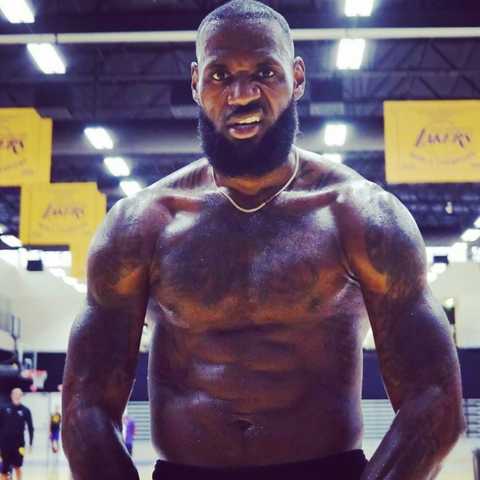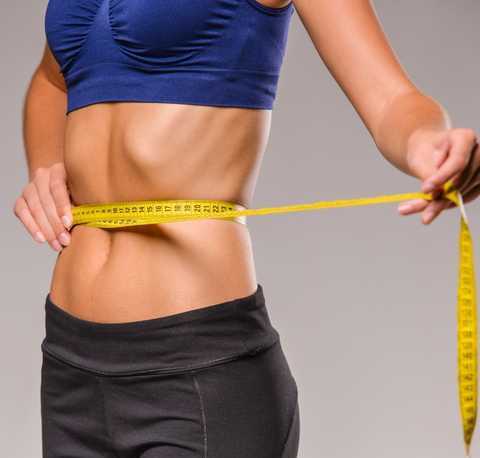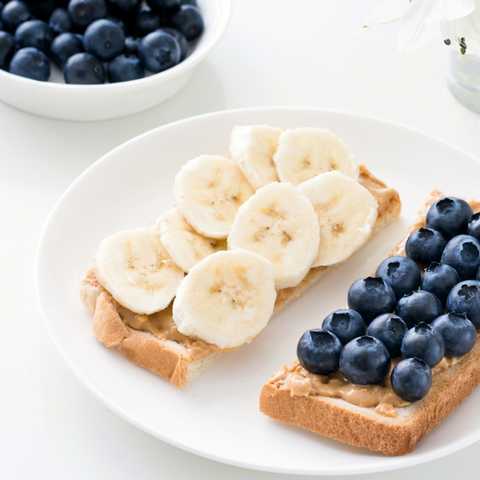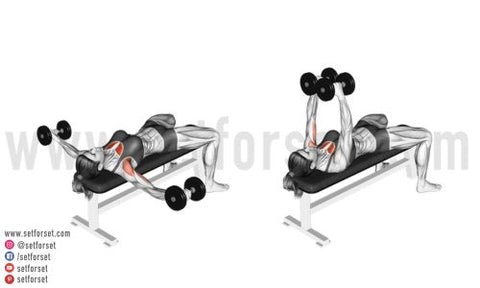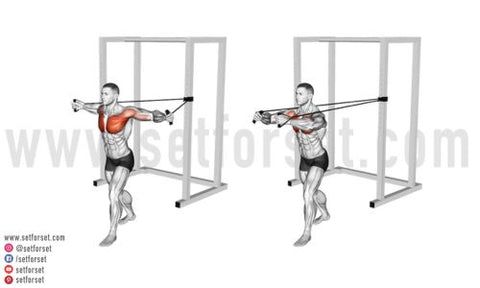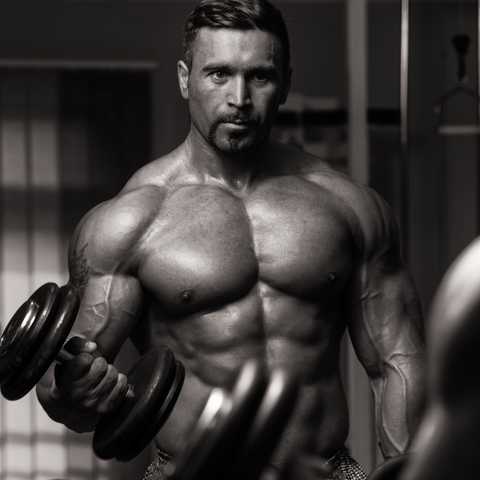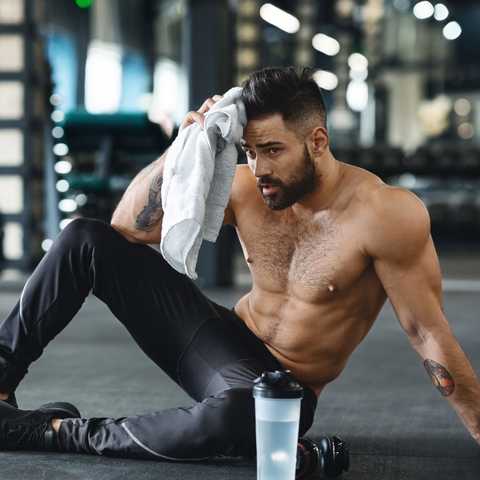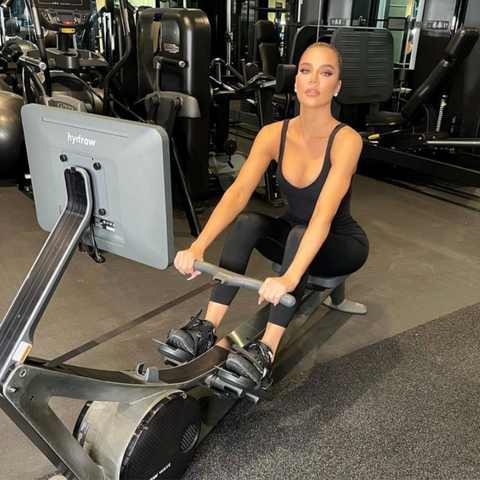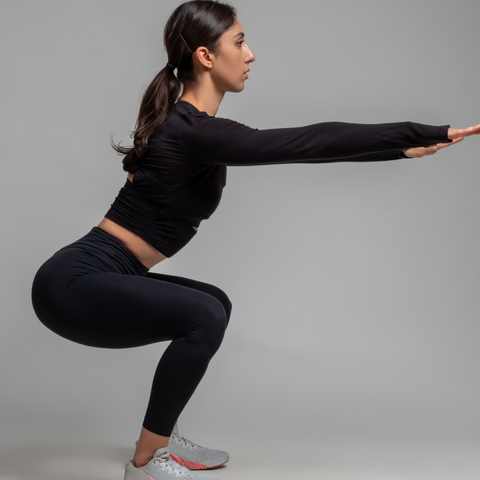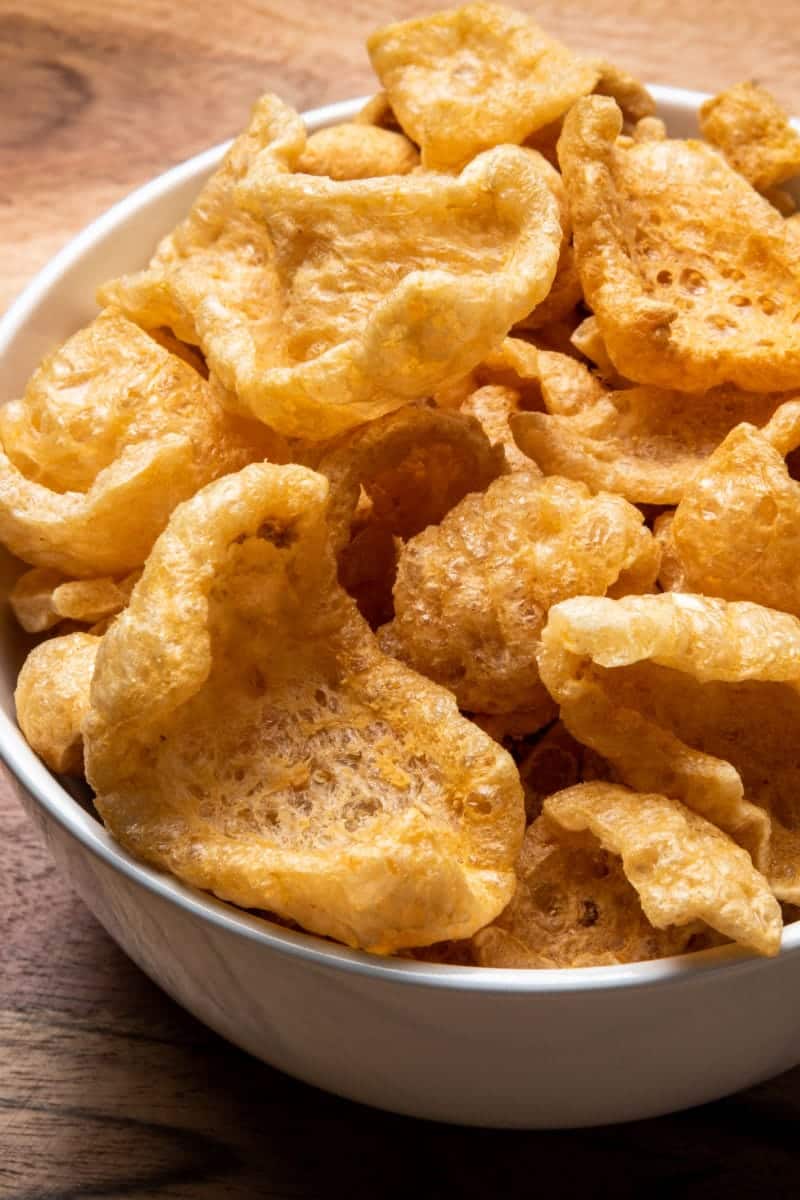Don’t get us wrong, crossovers are a fantastic exercise with tons of benefits for building slabs of chest muscle, but there are certainly other options that produce similar effects on the pecs (rhyme intended).
So, whether the cable machine is being hogged by somebody else taking Instagram videos or you don’t have access to one at your gym, we’ve got you covered.
Here is what we will cover in today’s article about alternatives to cable crossovers:
- What is a cable crossover?
- Are the cable crossover & cable fly the same exercise?
- How to perform the cable crossover
- Cable crossover muscles worked
- Benefits of cable crossovers
- Can you get similar benefits with cable crossover alternatives?
- What makes a good cable crossover alternative?
- Why use cable crossover alternatives?
- 13 best cable crossover alternative exercises
- Programming tips
- FAQs

What is a cable crossover?
The cable crossover is a chest isolation exercise that uses a cable crossover machine to target the pectoral muscles. What’s great about the crossover is the versatility to change the cable height to target different portions of the chest. The most common variation will be the high-to-low crossover, but you can do this exercise low-to-high and at a middle angle as well.
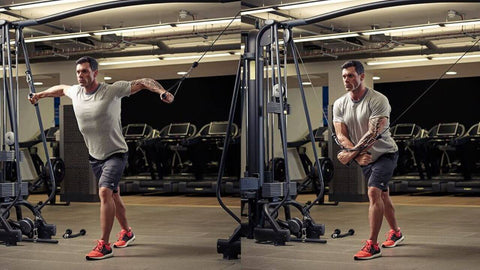
The cable crossover mainly targets the pec major, with emphasis on the lower and inner fibers of the muscle. And while you cannot completely isolate one muscle, the cable crossover is considered more of an isolation chest exercise due to it being a single joint movement (your elbows should remain pinned in position, so just your shoulder joint is moving).
Because it is an “isolation exercise”, the cable crossover makes for a great warmup or finisher for the chest muscle group. What’s more, the movement allows the pecs to stretch deeply before contracting, which is great for eccentric contraction and it helps build a great mind-muscle connection that can be challenging to replicate on a bench press since many other muscle groups are hard at work.
Are The Cable Crossover & Cable Fly the Same Exercise?
This answer can be confusing, but yes and no. These two exercises are the same up until the final portion of the range of motion. A cable fly will stop with the hands or even just the pinkies touching to finish the chest contraction. The crossover will allow the hands to cross over one another and take the arms ever so slightly past the midline of the body, allowing the pecs to get an even greater contraction.
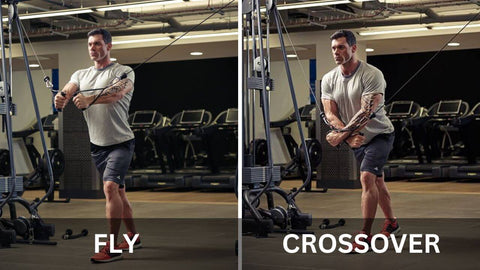
Now some of this is apples to apples and will come down to your preference, but if you follow the science of what the chest does, it functions to adduct your arms (hugging motion), so bringing them slightly farther across is likely to increase pec activation.
The crossover has many variations, some of which are performed in more of a pressing fashion with palms down, and that can be a great exercise as well, but the cable crossover variation we are referring to in this article is with palms facing each other in a neutral grip position similar to the cable fly. Either way, both of these movements maximize the benefits of the cable stack’s versatility to create maximum and consistent tension on the chest muscles throughout the exercise, which will help them grow.
How to Perform the Cable Crossover
The beauty of the cable machine and the crossover chest exercise is you can move the pulley height up or down to better target the upper, middle, or lower chest.
- High-to-Low Angle = Lower/Middle Chest
- Low-to-High Angle = Upper/Middle Chest
- Middle Angle = Middle Chest
All variations will do well to carve out the inner area of the pecs.
The variation we will describe below is the high-to-low crossover with palms in a neutral grip. The good news is, it’s essentially the same movement no matter what height you choose, you’ll just be bringing your arms in at a different angle.
Here is how to perform the high-to-low cable crossover:
- Set your handles at the highest level on your cable stack and stand in the center of the machine after grabbing each cable with palms facing each other.
- Make sure your feet are shoulder width apart and lean forward slightly while keeping your back flat and core engaged as if you were holding a plank (note: you can also use a staggered stance as demonstrated in the video above).
- Put a slight bend in your elbows and begin to squeeze your chest muscles, and pull the cables down and across your body as if you were hugging someone.
- Take your hands past each other, with one crossing over the top of the other as if you were making an x with your forearms at the end of the rep. Pause for a moment here.
- Slowly reverse the motion and feel the stretch in the chest as it lengthens back to the starting position while keeping your elbows slightly bent.
- Repeat and alternate which hand crosses over the other for indicated reps.
Remember, your elbows should keep the same bend throughout the entire movement. Also, try to keep your shoulder blades retracted at all times.
Cable Crossover Muscles Worked
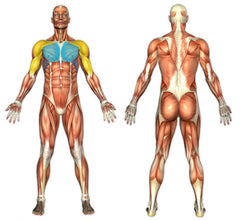
Pectoralis major: This is the biggest chest muscle in your body, and it’s your main focus on what you are trying to grow with the cable crossover exercise. These large fan-shaped muscles have two distinct heads, the sternocostal and clavicular.
The sternocostal is the lower head and starts at the sternum before inserting into the humerus. While some refer to this head as the “lower chest”, it actually accounts for around 80% of the size of your pec major. The clavicular head begins at the collar bone, inserts into the humerus, and is commonly known as the “upper chest”.
During the cable crossover, the pec major’s primary function is adducting your arms towards the centerline of your body and internally rotating the upper arm. This is why the extra range of motion when you cross the cables over each other provides additional pec contraction. It’s important to remember that the cable can be adjusted to any position to change what part of the pec major it’s emphasizing.
Pectoralis minor: The smaller chest muscle is triangular in shape and lies beneath the pec major. It starts from your ribs and inserts into the coracoid process on your scapular. Although it cannot be seen, it is still essential for stabilizing the scapula during movements. When you lean your upper body forward to begin the cable crossover, the pec minor plays a huge role in stabilizing everything.
Serratus anterior: The serratus anterior may not be one of your chest muscles, but it still has a vital role during chest exercises, especially the cable crossover. This is the muscle under your armpit at the bottom of your chest that, when visible, looks like feathers. It is often called the boxer’s muscle because it brings your arms forward. It pulls the scapular forward around your thorax, which is precisely what it does during the cable crossover. Controlled protraction of the scapula is very important during chest exercises.
Anterior deltoid: The deltoid is the muscle of your shoulder that sits on top of your upper arm and has three heads. The head that is active during the crossover is the anterior deltoid. This head is responsible for shoulder flexion and works with the upper chest during this movement. It also assists with internal rotation and adduction of the humerus.
Biceps brachii: This muscle bulges out of the front of your arm and has two heads. It attaches to your upper arm and then to your scapula. The biceps work to stabilize during the crossover as they help bend your arms. The biceps work in a static hold to maintain position during the crossover, so you likely won’t grow massive arms from this exercise. Still, they do play a pivotal role and have to be strong enough to keep your arm and elbow in position so you can target your chest.
Benefits of Cable Crossovers
- Constant tension: The cables provide the most bang for your buck regarding keeping tension on a muscle. With a dumbbell, you ask gravity to give the force throughout the movement, and at the top of the rep, you are not getting the same tension as you would on the cable. The cables keep this tension constant throughout the movement as they pull to stretch the muscles from a lengthened position and as they contract, taking them into the shortened position.
- A bigger range of motion: As they keep that constant tension we just mentioned, the crossover allows you to go farther by crossing your hands over each other. Remember, the role of the chest is to adduct your arms and internally rotate them, so this extra couple of inches has profound benefits for feeling that pec contract and ultimately signaling to your body that they need to grow.
- Mind-muscle connection: Sometimes, during a bench press, we all have been guilty of doing whatever we can to press that heavy weight back up off our chest. This is amazing for strengthening multiple muscle groups, but sometimes you can have difficulty feeling the chest contract during this movement because there are so many moving parts. The crossover allows you to connect to feeling the chest contract and stretch as it lengthens. Not only does this help during this exercise, but the better you get at it, the better you will start to feel the chest work during other movements.
- Bigger pecs: Put all of these things together in a pot, and what do you get? Bigger pecs that fill out that T-shirt and announce your presence when you walk into a room. More tension and a better mind-muscle connection allow you to increase the hypertrophy of these muscles. Adding cable crossovers into an appropriate chest training program will help grow those pecs if they have been lagging.

Can You Get Similar Benefits With Cable Crossover Alternatives?
You can absolutely get similar benefits with alternatives. The real benefit of beginning to understand these movements and how they work is that you can know what movements are activating what muscle groups based on what actions those muscles perform. If you are using a cable crossover to build your upper chest, plenty of other movements also target that area, like an incline bench press or reverse grip bench press. However, as always, certain people will respond better to specific exercises, so it will take some trial and error to figure out what works best for your body.
What Makes Good Cable Crossover Alternatives?
To find a suitable alternative, you must decipher what the crossover is doing in your program. Most people do this as a finisher to cook the chest as much as possible at the end of their workout. This means you aren’t going to be doing a crossover as your strength-building compound exercise in your program. Let’s say you are doing low-to-high crossovers for the lower chest. A decline dumbbell bench press would provide a similar stimulus for those chest fibers. Vice versa, if you performed a high-to-low crossover for the upper chest, an incline bench press would provide a similar stimulus for those fibers.
Why Use Cable Crossover Alternatives?
Most gyms don’t have multiple cable machines, and some sad ones don’t have one at all. So whether the gym is busy and it’s difficult to get onto the machine, or you simply don’t have access to it, you always need a plan B for some movements. These alternatives in your back pocket will ensure that you aren’t leaving gains on the table and skipping exercises that would help carve out the muscle you are focusing on for the day.
13 Best Cable Crossover Alternative Exercises
While the cable crossover is an effective exercise for the pecs, it’s by no means the only option. If you don’t have access to a cable machine, the following exercises are the best alternatives to the cable crossover.
1. Incline Dumbbell Fly:
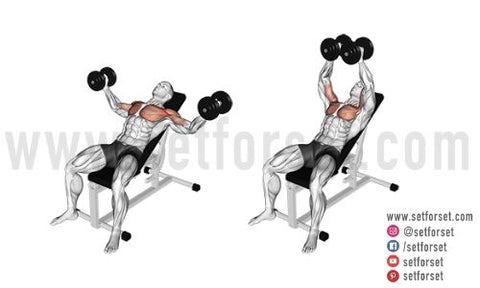
This fly variation is a great crossover alternative as it does a fantastic job of targeting the upper chest fibers. The bench allows you to use more weight than a cable crossover since your body is supported, providing more stimulus to the pecs.
- Set an incline bench to a 45-degree angle and sit down with your dumbbells.
- Press the weights above your chest and turn your palms, so they face each other. Place a slight bend in your elbows.
- Slowly take your arms out to your sides like you are making a T with your body, and lower the weights down until they are in line with your shoulders.
- Squeeze your pecs together to bring the weights back to the starting position while keeping that slight bend.
2. Flat Bench Dumbbell Fly:
Similar to the incline dumbbell fly, this variation allows you to use more weight than the cable crossover. If you are not trying to hit as much of your upper chest, this is another excellent option to target the middle portion of the chest fibers.
- Sit down on a flat bench with your dumbbells.
- Press the weights over your chest and turn your palms so they face each other with a slight bend in your elbows.
- Slowly lower the weights to your sides like you are making a T with your body. Lower until the weights are in line with your shoulders.
- Squeeze your pecs to bring the weights back to the starting position while keeping that slight bend in your elbows and tension on your pecs.
3. Single-Arm Dumbbell Bench Press:
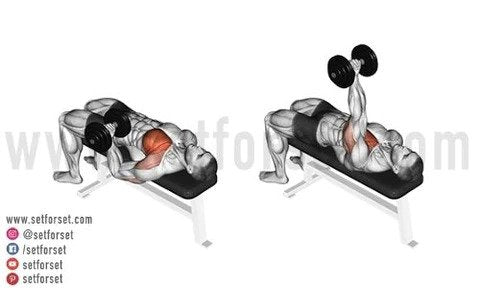
This unilateral variation gets the nod over the standard dumbbell bench press (also a great exercise) because of its ability to fix imbalances and increase the mind-muscle connection. While doing one side at a time, you can feel the chest contract and anti-rotation benefits for the core.
- Grab your dumbbell and lie down on a flat bench.
- Press the weight above your chest and turn your palm to face your feet.
- Bend your elbow and slowly lower the weight, taking your elbows at a 45-degree angle to your body. Lower until your arm makes a 90-degree angle or just slightly past that.
- Press the weight back overhead, contracting your pec as it brings the arm back towards the midline. Repeat.
4. Chest Dips:
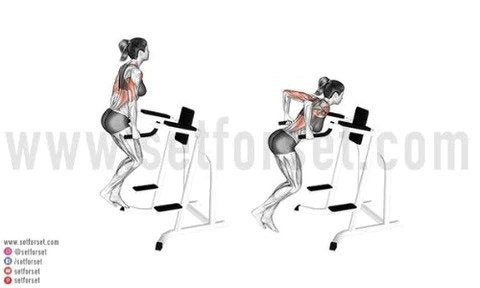
This bodyweight exercise is fantastic for building the upper chest and can be regressed using the assisted machine if necessary. This dip variation has a forward lean to emphasize the pecs and should be distinct from the more vertical tricep dip variation.
- Place your hands on the bars and elevate your body up above the bars. Lean your upper body forward around 30 degrees.
- Slowly lower yourself down with elbows coming to a 45-degree angle away from the body. Lower until you feel a stretch in the pecs and your arms are close to a 90-degree angle.
- Press your hands into the bars to push yourself away and back to the starting position.
5. Push-ups:
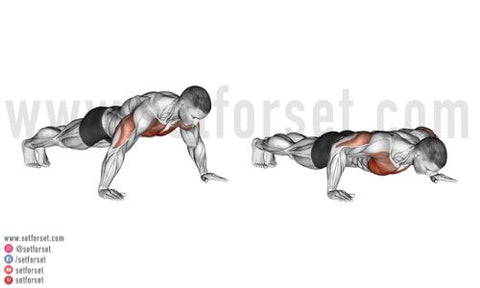
The push-up is a timeless bodyweight exercise for training the chest. There are countless push up variations that you can progress toward as you get stronger. This can act as a great finisher or warmup exercise.
- Set your hands just outside shoulder width apart and push yourself up into a high plank position with your feet together and back flat.
- Keeping your body in one solid line, bend your elbows and take them at a 45-degree angle away from your body as you begin to lower down towards the floor.
- Get as close to the floor as possible and push yourself away from the ground as if you were pushing your pecs together on the way up.
6. Dumbbell Pullover:
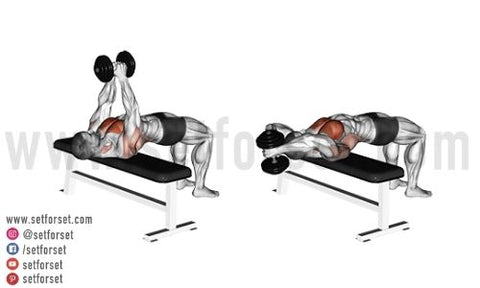
The pullover is terrific as it teaches the chest and lats to work together. With your elbows bent, this variation will be done, so the emphasis is placed more on the chest as the shoulders flex and extend.
- Lay down on a flat bench and raise a dumbbell over your chest as you grab the end with both hands. The bottom of the dumbbell should be hanging vertically beneath your hands.
- Keep your back flat, tuck your shoulder blades down, and begin to lower the weight over your head while keeping your arms slightly bent and shoulders slightly rotated.
- Lower until you feel a stretch in the chest, and then squeeze the chest to bring the weight back to the starting position.
7. Resistance Band Crossover or Chest Fly:
No cables? No worries! This exercise is the most directly linked to the cable crossover. You will perform the same exercise using a resistance band instead of cables.
- Anchor two resistance bands to a rack or pole (whatever you have available)
- Grab the bands with each hand as they cross behind your back. Walk forward until there is enough tension, then slightly lean your body in a split stance.
- Keep a slight bend in each elbow and bring your hands together in front of your body as if you are going to hug someone. For the crossover variation, take one hand over the other a few inches past the midline of your body. For the regular fly version, stop just before your hands meet at your centerline.
- Slowly return to starting position and repeat.
8. One-Arm Landmine Press:
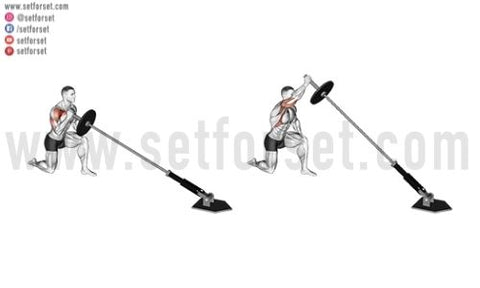
This exercise is great because it builds the upper chest and creates functional solid shoulders for all your pressing movements. Even if you don’t have a landmine attachment, you can simply place the barbell in a corner to do the exercise.
- Set the bar up in a landmine attachment or the corner of a wall. Pick the bar up with one hand as you stand up straight and bring the bar to shoulder level. You should be leaning slightly on an angle.
- Keeping your elbow in slightly, keep your knees soft and core engaged as you press the bar forward. As the bar pushes forward, you will begin to lean your upper body slightly forward to finish the press with your arm close to your ear.
- Slowly lower back down and repeat.
9. Svend Press:

This is the most unique exercise on the list. As you squeeze the plates and press away from your body you will create a massive chest contraction as your pecs try to push together.
- Stand up straight and grab a weight plate (or a dumbbell as shown in the pic above – either option will work fine). Squeeze both palms into it at chest level as if you are trying to crush the plate between your hands.
- To maintain that posture, press the plate away from your body until your arms are straight while keeping that tension pressing into the plate.
- Slowly bring the arms back in while squeezing the entire time and repeat.
10. Pec Deck:
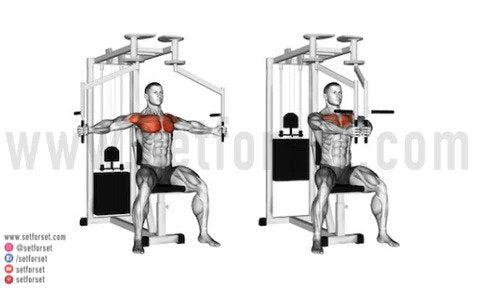
This machine variation is a stellar option to finish off the chest, as the machine takes any extra stability out of the equation. Its main job is to isolate the chest as much as possible, and it does just that in a movement similar to the crossover.
- Sit down on the pec deck and adjust the handles to the appropriate setting for your height.
- Grab the handles and keep your back flat against the pad. Place a slight bend in your elbows with your palms facing each other.
- Squeeze your pecs together as you bring the handles in front of your body towards the midline. Squeeze until your hands are almost touching, and pause to feel the contraction.
- Slowly lower back to the starting position and repeat.
11. Reverse Grip Bench Press:
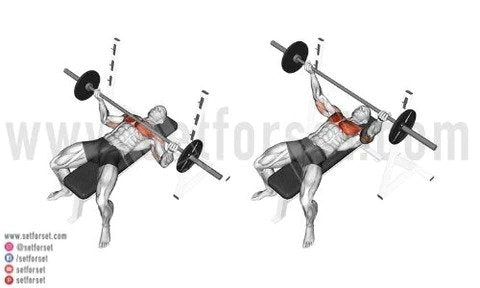
This is a different pressing exercise that does a great job of targeting the upper chest. It does require a steeper learning curve so be careful if you are a newer lifter. It can be performed with dumbbells if the barbell is too challenging for your wrists.
- Lay down on your bench and grab the bar with an underhand grip slightly wider than your regular bench press grip.
- Make sure the bar is in the palm of your hand and your wrists are slightly extended to make sure you don’t drop the bar.
- Press the weight off the rack and above your chest line. Begin to bend your elbows and lower the bar down to your sternum while keeping your elbows tucked into your body.
- Tap the bar on your shirt without bouncing it, and press the bar up and back toward the starting position. Repeat.
12. TRX Chest Fly:
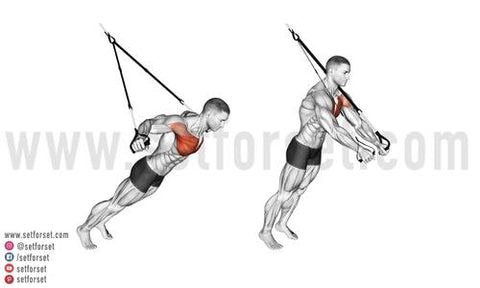
Where the push-up acts as your bodyweight pressing movement, this movement allows you to perform a bodyweight fly similar to the cable crossover exercise. Not only does this provide a great stretch and contraction of your chest, but it will also be fantastic for your core.
- Grab your TRX suspension trainer handles and face away from the anchor point.
- Line your arms up in front of your chest in line with your shoulders, and turn your palms to face each other.
- Keeping your body in a flat line like a plank, put a slight bend in your arms and begin to take them out to the sides like a cable fly as you send your body forward towards where your hands were.
- Keep taking your hands away as your body comes forward until your elbows are in line with your shoulders. Squeeze your chest and drive your hands towards each other to complete the rep.
13. TRX Crossover:
This is the same exercise as the cable crossover, except you use your body weight as the resistance via a suspension trainer. It will hit the chest the same way and target your core as you move.
- Grab your TRX handles and face the anchor. Walk your feet in and lean back on an angle while straightening your arms.
- While keeping your back flat and legs straight as if you were holding a plank, Pull your arms across your body while bending your elbows and allowing your hands to cross over one another.
- Lower back to the starting position and alternate sides.
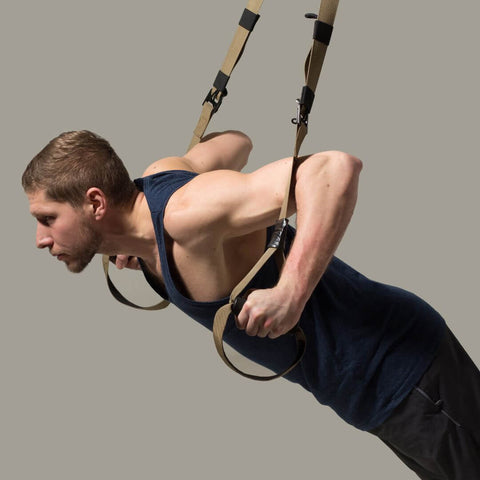
Programming Tips for Cable Crossover Alternatives:
The key to programming these alternatives is to know what they are doing in your chest program. You wouldn’t substitute a bench press with a cable crossover. You’ll need to look and see if you have exercises hitting each part of your chest. A movement like a crossover or push-ups can be a great warmup exercise to get a pump and blood flowing to the chest before starting your bigger compound movements like a bench press. Then you can use a crossover or alternative to isolate the muscle afterward.
For hypertrophy, stick to around 3 sets of 8-12 repetitions. For muscular endurance or a high rep finisher, try 2-3 sets of 15-20 repetitions. These movements are generally not done in a strength rep range lower than 8 reps. However, some bodyweight exercises may be challenging at first if you haven’t done them. You can progress the reps each week as you get stronger. Moreover, strength is built in the “hypertrophy” rep range, and hypertrophy (muscle growth) can occur in any rep range.
Cable Crossover Alternative FAQs:
- How do you do a cable crossover without cables? You can use two bands anchored to a rack or pole. Then you can perform the same crossover exercise as you use them the same way you would the cables.
- Is cable crossover necessary? It is not necessary but it is a great option to isolate the pec muscles.
- Can you do cable crossovers with dumbbells? You can perform a dumbbell fly, but it is not recommended to cross the dumbbells over one another as the cable tension is not there and can be dangerous for your shoulders.
- Are cable crossovers good for chest? Cable crossovers are a great chest isolation exercise that allows the chest to stretch from a lengthened position and contract to a shortened position.

